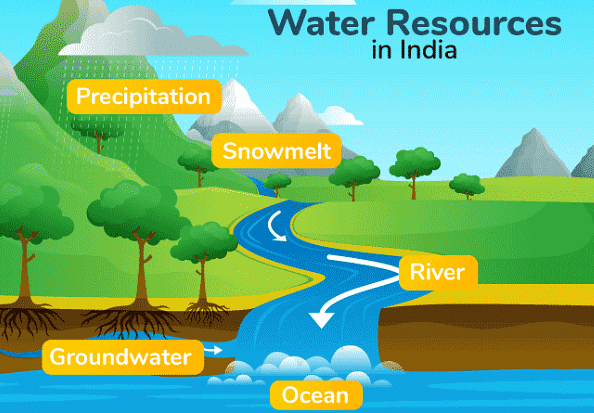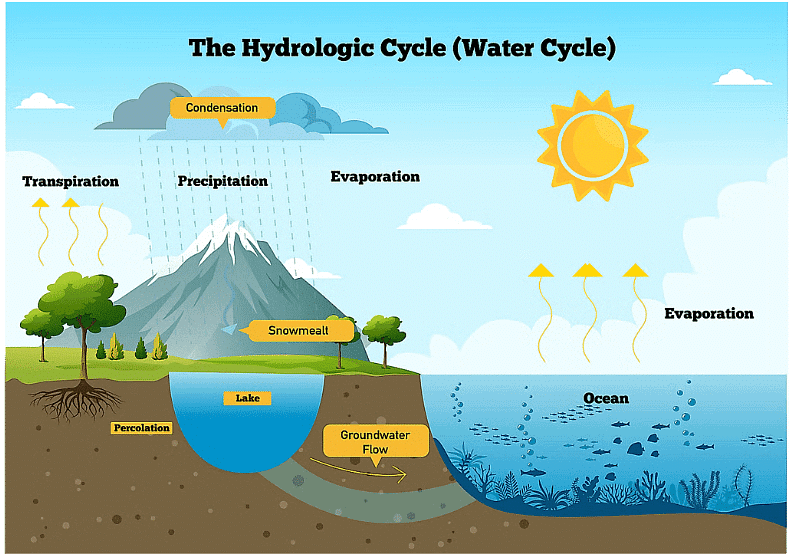Class 10 Exam > Class 10 Notes > Geography for GCSE/IGCSE > Hydrological Characteristics
Hydrological Characteristics | Geography for GCSE/IGCSE - Class 10 PDF Download
The Characteristics & Processes of Rivers
Water on Earth
- Only 2.5% of Earth's water is freshwater.
- Glaciers and ice sheets hold 68.7% of freshwater, while groundwater constitutes 30%.
- The remaining 1.3% of freshwater is distributed among rivers, soil moisture, lakes, and the atmosphere.
- All water participates in the hydrological cycle.

Question for Hydrological CharacteristicsTry yourself: What percentage of Earth's water is freshwater?View Solution
The Hydrological Cycle
- The hydrological cycle operates as a closed system.
- Water undergoes continuous recycling within this system.
- Within the hydrological cycle, there are reservoirs and movements (transfers).

Stores of Water
Stores refer to places where water is held for a period of time. They encompass:
- Water in the atmosphere, either as water vapor or water droplets in clouds.
- Surface stores like puddles, lakes, rivers, and reservoirs.
- Interception, which occurs when precipitation is hindered from reaching the ground, often by getting caught on leaves or branches.
- Aquifers, which are permeable rocks such as limestone and sandstone capable of holding water.
- Ice, snow, seas, and oceans.
Flows of Water
Flows represent the ways in which water moves through the hydrological cycle. These include:
- Evaporation: The process where water transforms from liquid to vapor due to heat.
- Condensation: The change of water vapor into liquid water, forming clouds.
- Transpiration: The release of water vapor by plants through their leaves.
- Evapotranspiration: The combined process of evaporation and transpiration from the Earth's surface.
- Precipitation: The release of water from clouds in the form of rain, snow, sleet, or hail.
- Overland flow: The movement of water over the land surface due to excess rainfall or snowmelt.
- Infiltration: The process by which water soaks into the ground surface.
- Percolation: The movement of water through soil and porous rock layers.
- Through flow: The lateral movement of water through the soil layer.
- Groundwater flow: The movement of water through underground aquifers and permeable rocks.
Question for Hydrological CharacteristicsTry yourself: Which process involves the movement of water over the land surface due to excess rainfall or snowmelt?View Solution
The document Hydrological Characteristics | Geography for GCSE/IGCSE - Class 10 is a part of the Class 10 Course Geography for GCSE/IGCSE.
All you need of Class 10 at this link: Class 10
|
55 videos|68 docs|78 tests
|
FAQs on Hydrological Characteristics - Geography for GCSE/IGCSE - Class 10
| 1. What are the main hydrological characteristics of rivers? |  |
Ans. The main hydrological characteristics of rivers include flow rate, volume of water, velocity, discharge, and sediment load.
| 2. How do rivers contribute to the water cycle? |  |
Ans. Rivers play a crucial role in the water cycle by transporting water from the land to the oceans, replenishing groundwater, and facilitating the circulation of water throughout the Earth's ecosystems.
| 3. What processes are involved in the formation of rivers? |  |
Ans. Rivers are formed through processes such as erosion, weathering, transportation of sediments, and deposition, which are influenced by factors like geology, climate, and topography.
| 4. How do human activities impact the hydrological characteristics of rivers? |  |
Ans. Human activities such as dam construction, deforestation, pollution, and urbanization can alter the flow rate, sediment load, and water quality of rivers, leading to negative impacts on aquatic ecosystems and water availability.
| 5. What are some strategies to manage and protect the hydrological characteristics of rivers? |  |
Ans. Strategies to manage and protect rivers include implementing sustainable water management practices, restoring riparian vegetation, controlling pollution sources, and promoting responsible land use planning to preserve the health and integrity of river ecosystems.
Related Searches















